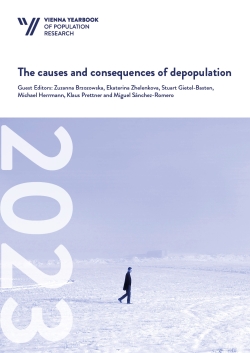
Vienna Yearbook of Population Research 2023, pp. 361, 2023/04/27
The causes and consequences of depopulation

Supplementary material
Supplementary file 1 (PDF)
Supplementary file 2 (Excel)
Supplementary file 3 (Excel)
Substantiated knowledge of future demographic changes that is derived from sound statistical and mathematical methods is a crucial determinant of regional planning. Of the components of demographic developments, migration shapes regional demographics the most over the short term. However, despite its importance, existing approaches model future regional migration based on deterministic assumptions that do not sufficiently account for its highly probabilistic nature. In response to this shortcoming in the literature, our paper uses age- and gender-specific migration data for German NUTS-3 regions over the 1995–2019 period and compares the performance of a variety of forecasting models in backtests. Using the bestperforming model specification and drawing on Monte Carlo simulations, we present a stochastic forecast of regional migration dynamics across German regions until 2040 and analyze their role in regional depopulation. The results provide evidence that well-known age-specific migration patterns across the urban-rural continuum of regions, such as the education-induced migration of young adults, are very likely to persist, and to continue to shape future regional (de)population dynamics.
Keywords: migration back- and forecasting; regional population decline; multivariate methods; principal component analysis; time series analysis; Monte Carlo simulation